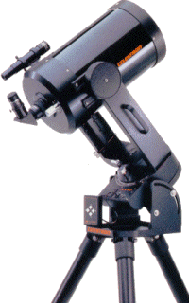
Many catadioptrics use a fork mount to cradle the telescope's short optical tube securely on two sides, reducing image-degrading vibration to a minimum. A fork-mounted catadioptric's slow motion controls, often not available on reflectors, makes the "fine tuning" of the telescope's position easy. And a catadioptric's setup and take down time is short, due to its folding tripod, lighter weight, and more compact size per inch of aperture. Essentially every current fork-mounted Schmidt-Cassegrain telescope is fully go-to computerized, making aligning on the sky fast and easy, so you can start observing sooner.
The catadioptric's drawbacks? First, the cost. An 8" Schmidt-Cassegrain costs 50% to 300% more than an 8" reflector (although about the same as a 4" refractor).
Second, Schmidt-Cassegrain catadioptrics do not have as wide a contrast range on the Moon and planets as a refractor or most f/6 to f/8 reflectors, because of the extra light scattered by its larger secondary mirror and its multiple-element folded light path, nor will it be able to split close binary stars as cleanly. However, a Schmidt-Cassegrain will usually outperform a fast (f/4.5)focal ratio reflector of similar aperture on the planets and binary stars due to its lack of diffraction-causing secondary mirror spider vanes. A Maksutov-Cassegrain, because it has a smaller secondary mirror obstruction, typically has better contrast than a Schmidt-Cassegrain, often rivaling that of a refractor of similar aperture.
Third, although their large apertures allow detailed deep space observing, catadioptrics generally do not have as bright an image as other scope types of similar aperture at the same power. A catadioptric can have a light transmission of 64% before secondary obstruction light losses are figured in (70% to 75% with multicoated optics), compared with the 90% of a similar aperture multi-coated refractor and the 77% to 80% of a reflector.
Finally, because of their eyepiece location at the bottom of the optical tube, catadioptrics on German Equatorial mounts are somewhat less comfortable to use than reflectors on similar mounts - when observing at the zenith, catadioptric eyepiece will typically be at waist level, moving to normal eye level only when the scopes are pointed towards the horizon. The eyepieces of fork-mounted catadioptrics are always at more or less eye level, no matter where the scopes are pointed, and are therefore more accommodating for visual observing.
Despite these drawbacks, if it fits your budget and you need a portable scope that does it all, you would be hard-pressed to find a better all-around investment than a good catadioptric.
CATADIOPTRIC REPORT CARDS FOR VISUAL USE
(used in excellent seeing conditions and with no light pollution; adapted from Astronomy Magazine):
E = excellent; VG = very good; G = good; F = fair; P = poor.
Small aperture (3.5" to 5") Schmidt- and Maksutov-Cassegrains:
Price range: $500-$4300
Portability: E
Ease of setup: VG
Ease of use: G+
Performance on the Moon: E
Performance on comets: F
Performance on double stars: G
Performance on galaxies and nebulas: F
Performance on planets: G
Medium aperture (6" to 8") Schmidt- and Maksutov-Cassegrains:
Price range: $1000-$4000
Portability: VG
Ease of setup: VG
Ease of use: VG+
Performance on the Moon: E
Performance on comets: G
Performance on double stars: VG
Performance on galaxies and nebulas:, G
Performance on planets:, G
Large aperture (9" to 16") Schmidt- and Maksutov-Cassegrains:
Price range: $1700-$20,000 and up
Portability: P+
Ease of setup: F
Ease of use: G
Performance on the Moon: VG
Performance on comets: VG
Performance on double stars: VG
Performance on galaxies and nebulas: VG
Performance on planets: VG








